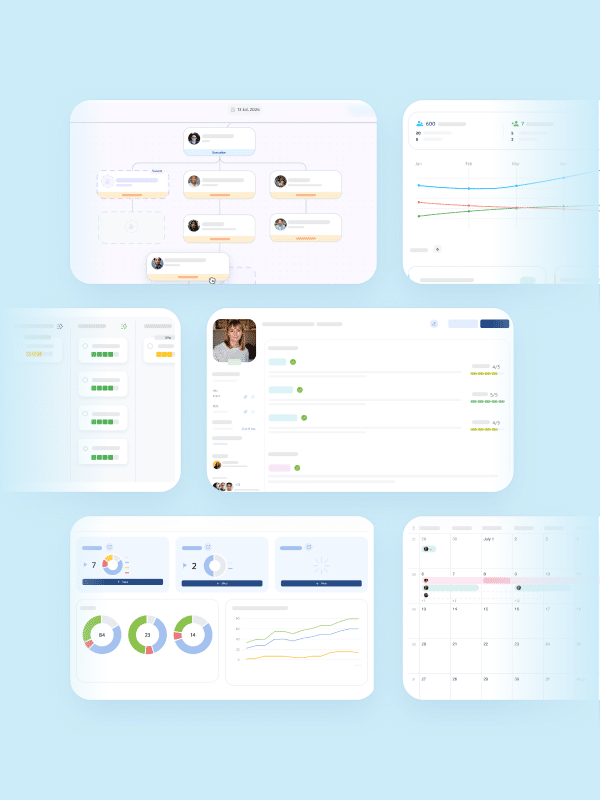Securing skills and increasing internal mobility is an effective strategy for reducing unwanted staff turnover and creating a stable and prosperous organization. By ensuring that the skills of existing staff are continually developed to meet the changing demands and challenges of modern working life, it is possible to increase the company’s competitiveness, retain qualified staff and create a dynamic and successful business in the long term. This Heartpace article focuses on ensuring competence and internal mobility by implementing effective competence and career development processes.
What is internal mobility?
Internal mobility refers to the possibility for employees to change positions or responsibilities within the same organization. Specifically, it means allowing employees to grow and develop within the organization by taking on new roles, responsibilities, or projects. Internal mobility is usually divided into vertical mobility (promotion to higher positions) and horizontal mobility (changing positions within the same hierarchical level). Good internal mobility allows organizations to retain and benefit from existing skills while offering employees development opportunities and broadening their experience base.

Reflections from an HR expert
By ensuring competence development and promote internal mobility your company is perceived as an attractive employer with an stimulating work environment where employees want to stay and develop.
Benefits of internal mobility
Increasing internal mobility has several benefits. Firstly, employees can develop and broaden their knowledge and experience by working in different departments, positions, or project teams. This, in turn, can lead to increased motivation and commitment, as employees can take on new challenges and grow professionally. Moreover, well-organized internal mobility can contribute to a better understanding and cooperation between different parts of the organization, which can improve the efficiency and productivity of the company.
A further benefit of increasing internal mobility is reducing the costs and uncertainties associated with recruiting and employing new employees. Investing in the skills development of existing staff reduces the company’s need to look externally for specific competencies. In addition, internal mobility reduces the risk of mis recruitment and short-term employment, which can be both costly and harm organizational efficiency and productivity.
Competences and internal mobility
Competence refers to the knowledge, experience, skills, and attributes that an employee possesses and can apply in their role in the workplace. On the other hand, internal mobility refers to employees’ ability to change roles, departments, or positions within the organization. When these two are combined, the organization can benefit from the existing skills and retain qualified staff long-term. All in all, skills and internal mobility are interdependent. By securing skills and stimulating internal mobility, the organization can create a strong and flexible workforce that is equipped to face the challenges and changes of modern working life.

Browse our webinar library!
We have a number of webinars about different HR related topics available to watch whenever you want.
Effective competence and career development processes
Implementing effective competence and career development processes to ensure competence and internal mobility can be crucial to an organization’s success. Here are some steps to consider:
1. Evaluate existing processes: start by reviewing and evaluating the existing competency and career development processes. Identify strengths, weaknesses, and areas for improvement.
2. Clarify competence requirements: Define clear competence requirements and career paths for different organizational roles and positions. This gives employees a clear picture of what is required to advance or change positions.
3. Create individual development plans: Work with each employee to identify development needs. Create individual development plans with concrete actions and resources to support skills and career goals.
4. Provide training and resources: Ensure that appropriate training, courses, and other resources are available to help employees develop the necessary skills.
5. Mentoring and coaching: Implement mentoring and coaching programs to facilitate knowledge transfer and support employee development. By connecting experienced employees with those interested in developing, knowledge and experience can be shared meaningfully.
6. Monitoring: regular monitoring and development discussions should be carried out to evaluate staff progress, identify opportunities for internal mobility and adjust development plans if necessary. But also to follow up and discuss the organization’s needs to ensure long-term success.
7. A culture of learning and development: Create a culture that encourages employees to actively seek development opportunities and be open to exploring new roles within the organization. This can usefully include encouraging learning and creating a positive attitude towards change.
In conclusion
To ensure competence and internal mobility, it is important to continuously evaluate and identify the competence and development needs of both the organization and its staff. Ensuring competence and internal mobility also offers an attractive and stimulating work environment where employees want to stay and develop. By continuously evaluating and improving the business’s competence and career development processes, the organization can create a winning combination of good competence and internal mobility that contributes to both growth and success.
If you are looking for a solution that gives you these opportunities and benefits, you are welcome to contact us to book a demo of the Heartpace HR System!

Do you want to see more?
Book a demo here to see Heartpace HR system
Explore more posts
Want to keep updated?
Subscribe to our blog posts, news and webinars here. We promise that we won’t overwhelm you with emails, nor will we never ever give your email address to anyone else!








